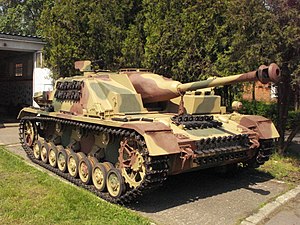|
Sturmgeschütz IV
The Sturmgeschütz IV (StuG IV) (Sd.Kfz. 167) was a German assault gun variant of the Panzer IV used in the latter part of the Second World War. It was identical in role and concept to the highly successful StuG III assault gun variant of the Panzer III. Both StuG models were given an exclusively tank destroyer role in German formations and tactical planning in the last two years of the war, greatly augmenting the capability of the dwindling tank force available to the German army on the Eastern and Western fronts. Development  The Sturmgeschütz IV resulted from Krupp's effort to supply an assault gun. As Krupp did not build Panzerkampfwagen IIIs, they used the Panzerkampfwagen IV chassis in combination with a slightly modified Sturmgeschütz III superstructure. The first known proposal for a Sturmgeschütz on the Panzer IV chassis is in Krupp drawing number W1468 dated February 1943. This initial drawing utilised the outdated Sturmgeschütz Ausf. F superstructure on a Panzer IV chassis. This proposal had a sloped front superstructure with a combat weight of 28.26 tons. Krupp abandoned it in February 1943 because it was too heavy. Plans for the StuG IV were halted. During the Führer Conference of 19 to 22 August 1943, after the Battle of Kursk, Hitler had seen reports of the StuG III outperforming the Panzer IV when used in an infantry support role and tactical defence. Convinced that a tank-hunter version would be superior to the tank version, Hitler planned to switch Panzer IV production to "Panzerjäger IV" production as soon as possible. It was to mount the same 7.5 cm L/70 used for the Panther. Another manufacturer, Vomag built a prototype Panzerjäger IV with 7.5 cm L/48 gun and demonstrated it on 20 October 1943. It was later re-designated as Jagdpanzer IV Ausf. F. As the Jagdpanzer IV was already being produced by Vomag, the StuG IV may not have materialized, had it not been for the major disruption of StuG III production, and the scarce supply of the 7.5 cm L/70 gun designated for the Jagdpanzer IV. In November 1943, Alkett, the manufacturer of the StuG III, suffered damage due to an Allied bombing raid. They produced 255 StuG III in October 1943, but in December production fell to just 24 vehicles. A conference held from 6 to 7 December 1943, addressed possible solutions to this problem. Hitler welcomed the suggestion of taking the StuG III superstructure and mounting it on a Panzer IV chassis. The StuG IV could be more quickly manufactured than the Jagdpanzer IV at the time. This restarted the Sturmgeschütz IV project. This time, the superstructure of the StuG III Ausf. G was mounted on a Panzer IV chassis 7, with a box compartment for the driver added. Combat weight was 23000 kg, lighter than the 23900 kg for the StuG III Ausf. G. Between 16 and 17 December 1943, Hitler was shown the StuG IV and approved it. To make up for the large deficit in StuG III production StuG IV production was now given full support. From December 1943 to May 1945, Krupp built 1,111 StuG IVs, in early 1944 Alkett built 30 Stug IVs using new Panzer IV chassis sent from Nibelungenwerk. While the number is smaller than the 10,000+ StuG III, the StuG IV supplemented and fought along with StuG III during 1944–45, when they were most needed. DesignThe StuG IV became known as an effective tank killer, especially on the Eastern Front. It had a four-man crew, and was issued mainly to infantry divisions.
Surviving vehiclesThere are presently six surviving examples of the StuG IV.
See alsoComparable vehicles
References
External links
|
||||||||||||||||||||||||||||||||||||||||||||||||||||||||||||

